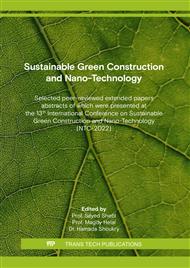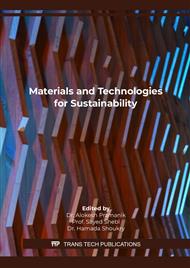[1]
Dolf Gielen, Francisco Boshell, Deger Saygin, Morgan D. Bazilian, Nicholas Wagner, Ricardo Gorini, The Role of Renewable Energy in the Global Energy Transformation, Journal of Energy Strategy Reviews 24(2019), 38-5, Information on: https://doi.org/10.1016/j.esr.2019.01.006.
DOI: 10.1016/j.esr.2019.01.006
Google Scholar
[2]
Arab Countries in Transition: An Update on Economic Outlook and Key Challenges, International Monetary Fund, April 9, (2014) p.10, Information on: https://www.imf.org/external/ np/pp/eng/2014/040914.pdf.
DOI: 10.5089/9781498343459.007
Google Scholar
[3]
U.S. Energy Information Administration (EIA), Country Analysis Brief: Egypt, (cited 2019), Information on: https://www.eia.gov/international/overview/country/EGY.
Google Scholar
[4]
Central Intelligence Agency (CIA), The World Fact Book Africa: Egypt,, Book, (2018), Available from: https://user.iiasa.ac.at/~marek/fbook/04/print/eg.html.
Google Scholar
[5]
Ergo Pikas, Lauri Koskela, Olli Seppänen, Improving Building Design Processes and Design Management Practices: A Case Study,, Journal of Sustainability12(2019), p.911.
DOI: 10.3390/su12030911
Google Scholar
[6]
Drury B. Crawleya, Jon W. Handb, Michae¨l Kummertc , Brent T. Griffithd, Contrasting the Capabilities of Building Energy Performance Simulation Programs,, Journal of Building and Environment 43(2008), pp.661-673.
DOI: 10.1016/j.buildenv.2006.10.027
Google Scholar
[7]
Crawley DB., Hand JW., Kummert M., Griffith BT., (2005):,Contrasting the Capabilities of Building Energy Performance Simulation Programs,, Washington, DC: US Department of Energy.
DOI: 10.1016/j.buildenv.2006.10.027
Google Scholar
[8]
Drury B. Crawleya, Jon W. Handb, Michae¨l Kummertc, Brent T. Griffithd, Contrasting the Capabilities of Building Energy Performance Simulation Programs, Building and Environment 43, (2008) pp.661-673.
DOI: 10.1016/j.buildenv.2006.10.027
Google Scholar
[9]
Rallapalli HSA., Comparison of Energy Plus and eQUEST whole Building Energy Simulation Results for a Medium Sized Office Building, Doctoral dissertation, Arizona State University, (2010).
Google Scholar
[10]
Information on https://designbuilder.co.uk/software/for-architects.
Google Scholar
[11]
Avatefi Nezhad M, Ghahraman Ezadi N, Ayatollahi SMH., Investigating the Flexibility of Traditional Houses from Yazd with Climatic conditions and presenting patterns to improve their current situation (case study: Rasoulian House in Yazd), 8th Symposium on Advances in Science and Technology Commission - III: From Vernacular Architecture to Sustainable City (VAS City), Mashhad, Iran, (2013).
Google Scholar
[12]
A. Eisabegloo, M. Haghshenas, A. Borzoui., Comparing the results of Thermal Simulation of Rasoulian House in Yazd by Design Builder software, with Experimental Data, International Journal of Architect Engineering Urban Plan 26 (2016), PP. 121-130.
Google Scholar
[13]
Lamberto Tronchin, Kristian Fabbri, Energy performance Building Evaluation in Mediterranean countries: Comparison between Software Simulations and Operating Rating Simulation, Energy and Buildings 40 (2008), PP. 1176-1187.
DOI: 10.1016/j.enbuild.2007.10.012
Google Scholar
[14]
Abdollah Baghaei, Daemei Armita, Khalatbari Limaki, Hossein Safari., Opening performance simulation in natural ventilation using design builder (case study: a residential home in Rasht). Energy Procedia 100 (2016), PP.412-422.
DOI: 10.1016/j.egypro.2016.10.196
Google Scholar
[15]
Mohammad Baharvand et all, Design Builder Verification and Validation for Indoor Natural Ventilation, Journal of Basic Application Science Research 3(4) (2013), PP. 182-189.
Google Scholar
[16]
Cheung, J. O. P., Liu C.H., CFD Simulations of Natural Ventilation Behavior in High-Rise Buildings in Regular and Staggered Arrangements at Various Spacings, Journal of Energy and Buildings 43 (2011), PP. 1149-1158.
DOI: 10.1016/j.enbuild.2010.11.024
Google Scholar
[17]
Qingyan Chen., Ventilation Performance Prediction for Buildings, A Method Overview and Recent Applications, Journal of Building and Environment 44(4) (2009), PP. 848-858.
DOI: 10.1016/j.buildenv.2008.05.025
Google Scholar
[18]
Senthil Kumar, Study of Properties of Geopolymer Eco Bricks, Journal of Civil Engineering 5 (2015), pp.139-148.
Google Scholar
[19]
Aeslina Abdul Kadir, Noor Amira Sarani, An Overview of Wastes Recycling in Fired Clay Bricks, International Journal of Integrated Engineering 4 (2012) pp.53-69.
Google Scholar
[20]
A. Eisabegloo, M. Haghshenas, A. Borzoui, Comparing the Results of Thermal Simulation of Rasoulian House in Yazd by design builder software with experimental data, Journal of Architect Engineering of Urban Plan 26 (2016), pp.121-130.
Google Scholar
[21]
Dhanushka Jayathilake , Chintha Jayasinghe, Thermal Performance of Composite Walls Made Out Of Recycled Building Waste and Stabilized Rammed Earth, (2016).
Google Scholar
[22]
Qingyan Chen, Ventilation performance prediction for buildings: A method overview and recent applications, Journal of Building and Environment 44(2009), pp.848-858.
DOI: 10.1016/j.buildenv.2008.05.025
Google Scholar
[23]
Livermore SR., Woods AW., Natural ventilation of a building with heating at multiple levels, Journal of Building and Environment 42(2007),pp.1417-30.
DOI: 10.1016/j.buildenv.2005.12.014
Google Scholar
[24]
Chenvidyakarn T, Woods A., Stratification and oscillations produced by precooling during transient natural ventilation, Journal of Building and Environment 42(2007),pp.99-112.
DOI: 10.1016/j.buildenv.2005.08.007
Google Scholar
[25]
Aeslina Abdul Kadir, Noor Amira Sarani, An Overview of Wastes Recycling in Fired Clay Bricks, Journal of Integrated Engineering 4(2012), pp.53-69.
Google Scholar
[26]
P. Lertwattanaruk , J. Choksiriwanna, The Physical and Thermal Properties of Adobe Brick Containing Baggase for Earth Construction, Journal of Architectural Planning Research and Studies 5 (2011), pp.187-199.
DOI: 10.56261/built.v1.170319
Google Scholar
[27]
Soad Aokhimis et all, A state of art for using Double skin façade in hot climate, 4th International Conference on Environmental, Journal of Energy and Biotechnology 85 (2015).
Google Scholar
[28]
Specifications of thermal insulation works, The National Center for Housing and Building Research (HBRC), Ministerial Resolution 176 (2008).
Google Scholar
[29]
OPUS 10 Climate Monitor for Temperature and Humidity, (Cited 2018), Available from: http://envcoglobal.com).
Google Scholar
[30]
Ahmed A. Saleem, Ali K. Abel-Rahman, Ahmed Hamza H. Ali, S. Ookawara, An Analysis of Thermal Comfort and Energy Consumption within Public Primary Schools in Egypt, Journal of Sustainability, Energy and the Environment 3(2016), pp.51-64.
DOI: 10.22492/ijsee.3.1.03
Google Scholar
[31]
GianpieroEvola, LuigiMarletta, SukumarNatarajan, ElisabettàMaria Patanè, Thermal inertia of heavyweight traditional buildings: experimental measurements and simulated scenarios, Energy Procedia 133(2017), pp.42-52.
DOI: 10.1016/j.egypro.2017.09.369
Google Scholar



